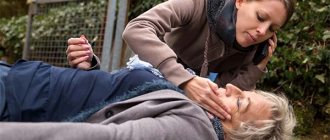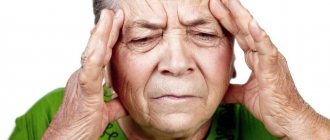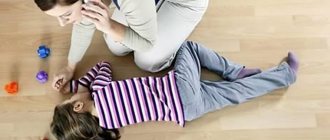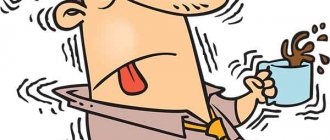.
Among the many human phobias, there are both unfounded and those with a real basis. Among the latter is the fear of fainting during a panic attack. In most cases, people experience such fear for a reason; perhaps they have already experienced bouts of loss of consciousness. Why does this happen and how to get rid of such anxiety?
Causes of fainting during VSD
There are many different diseases that can cause semi-fainting and fainting.
But dystonics, for the most part, are physiologically quite healthy people. Nevertheless, it is necessary to undergo diagnostics and exclude diseases that cause similar symptoms. The information given here applies only to cases where no serious organic causes of fainting have been found. And the only diagnosis on the patient’s card is vegetative-vascular dystonia. In such cases, the cause of the most unpleasant condition during VSD may be:
- Lack of oxygen. Neurotic people often experience increased anxiety. This, in turn, causes muscle tension. The fossilized muscles survive the vessels through which the blood carries oxygen. When there is insufficient blood flow, the brain is the first to suffer from lack of oxygen. After all, in a vertical position, the least amount of blood flows to it. To protect itself, it simply goes into “energy saving” mode and turns off for a while. In fact, such fainting during VSD is nothing more than a protective reaction of the body.
- Decrease in pressure (hypotonic crisis). Unstable blood pressure is a typical symptom of dystonia. Sometimes its jumps are so sharp and fast that the vessels do not have time to rebuild. When the pressure in them drops, they do not compress properly, which also leads to insufficient nutrition to the brain.
- Sluggish, dilated vessels. This factor also often accompanies people with VSD. The vessels lose their tone, become “flabby” and blood flows through them slowly. As a result, the brain, which does not have enough oxygen, suffers again.
- Hyperventilation of the lungs. It usually occurs during panic attacks. The unfortunate person begins to breathe frequently, but superficially. The body does not have time to become saturated with oxygen and the person loses consciousness.
Many feel the pre-fainting state in the same way - the eyes begin to darken, a ringing is heard in the ears, nausea may set in, coordination of movements is lost, and the body becomes weak. Usually all this happens when a person is in an upright position. However, it does not always end in complete fainting. If the victim manages to sit down in time or someone waves at him or throws cold water on him, he may not pass out completely. In any case, this condition is extremely dreary and unpleasant.
Fainting in a child
Fainting in a child is a short-term loss of consciousness. Initially, the child complains of severe weakness, he is bothered by tinnitus, headache, and darkening of the eyes. His skin turns pale, his eyes roll back and he falls. If a child falls, he or she may be injured or hit hard. The child may be unconscious for several seconds to minutes. Afterwards he begins to come to his senses, but he still feels weak and has pain in his head. Young children may fall asleep immediately after fainting. What reasons contribute to this situation?
If a child suddenly faints, the reason is a disruption in the functioning of the brain due to a sharp outflow of blood. For some time, the little patient loses sensitivity and cannot control his movements.
Symptoms:
- a sudden surge of weakness - the child sag, the skin turns pale;
- mild attack of vertigo, darkening of the eyes;
- nausea, severe tinnitus;
- unstable pulse;
- increased sweating.
The baby suddenly sinks to the ground and does not react to what is happening around him for half a minute. After the fallen person has regained consciousness, he does not realize for some time what happened to him, being in prostration.
At the rehabilitation stage, the victim begins to have a headache, nausea, and unpleasant discomfort in the chest or heart. This condition can last for some time, and depends on the cause of sudden fainting and weakness in the teenager, and first aid.
Causes:
- lack of vitamins. Low hemoglobin;
- lack of nutrition. Low blood sugar;
- strong cry, fright, stress, fear;
- pathologies of blood vessels, heart;
- overwork.
External factors
- A sharp increase in temperature outside.
- Lack of oxygen.
- Increased levels of carbon oxides in the air.
The causes of fainting in children may be different, but they do not go away without leaving a trace. If treatment for the pathological condition is not started in a timely manner, the syndrome will subsequently be accompanied by constant dizziness, nausea, headaches, and memory problems.
Internal factors
If a child’s fainting and nausea are short-term, this is a reason to think about changing the daily routine. Systematic loss of consciousness is a pathological condition that cannot be ignored.
Fainting, ailments in adolescents and their causes may be associated with the following diseases:
- Brain diseases. Cystic formations, tumors, and injuries to the vascular network reduce the efficiency of the “gray matter” functioning, causing fainting. If a child complains of darkening of the eyes, headaches, or hallucinations, it is necessary to urgently consult a doctor and undergo a CT and MRI.
- Anemia. Pathology of the circulatory system associated with the functioning of the organ: low levels of red blood cells - oxygen carriers, cause starvation, which leads to constant fainting. Low hemoglobin is the first sign of the onset of the disease. It is necessary to review the child’s diet, supplement it with fruits, vegetables, and nutrients.
- Impaired performance of the heart muscle, arrhythmia. According to statistics, 30% of crises are associated with heart pathologies; in addition, the “quick death” syndrome is preceded by constant fainting. If the baby’s parents suffer from similar diseases, this is the first warning call - the child needs to be shown to the doctor urgently.
- High pressure. Hypertension can overtake a patient, even at a young age. A sudden drop in blood pressure can also cause syncope.
- Diabetes. This disease is quite insidious: it can occur in a latent form for a long time. The pathology itself does not cause fainting, but it can be triggered by low glucose levels. Due to starvation of the “gray matter” cells, the baby loses consciousness.
- Concussions, TBI. Children are hyperactive; they lose their balance and fall, which is normal for them. After a short cry, they can continue to go about their business, but sometimes the consequences of a fall can remind themselves for a long time.
- Osteochondrosis. Ideal posture is the key to a healthy back and proper functioning of internal systems, but this is difficult to prove to children. A crooked posture at the table and excess body weight lead to changes in the spinal column. Blood flow is disrupted, starvation occurs, and painful discomfort appears. All these factors are the main causes of syncope.
Diagnostics
The following specialists can diagnose the cause of fainting:
- pediatrician;
- cardiologist;
- neurologist.
To clarify the diagnosis, you will be referred for tests and studies:
- Clinical analysis of urine and blood;
- biochemical blood test;
- EEG;
- MRI;
- CT;
- Ultrasound.
First aid for fainting
- Place the victim on a horizontal surface. Raise your legs slightly to ensure adequate blood flow to the “gray matter.”
- If you faint, you should let your child smell ammonia or pat him on the cheeks. This will allow the baby to regain consciousness.
- After the condition has normalized, the victim should be given sweets - chocolate, candy, tea with sugar. The baby should lie down until he comes to his senses.
- Ensure proper oxygen circulation. If the attack occurs indoors, you should open the doors and windows, allowing air to flow into the room. In case of a large crowd of people, you must ask them to move away from the baby.
The Epihelp clinic offers diagnostics and treatment. Qualified doctors will draw up a treatment plan. With our clinic, your child will recover much faster!
How to lose consciousness for a few minutes
Real loss of consciousness is caused by simple manipulations. The downside is harm and health hazard.
It will not be possible to accurately adjust the time of fall. You can create conditions for the body to weaken.
People in good health will have to use one of the above techniques in addition:
- Starvation.
- Depressant.
- Dehydration.
- Severe stress.
- Clothing that tightly pinches the chest and abdomen, preventing normal breathing.
- Hit to the head.
These methods are effective, but harmful. A blow to the head is mentioned because it can cause loss of consciousness. To use it is to risk your life.
The blow can cause brain bleeding. The person will forever remain disabled, immobilized, blind, or die. One blow to a sensitive spot and death is guaranteed.
Fasting can weaken the body, but along with a faint state, be prepared for stomach problems: ulcers, gastritis, indigestion, colitis. Such experiments leave consequences.
Tight clothing is an option that works on the principle of breathing manipulation. Lack of oxygen will contribute to fainting. Make sure there are people nearby who will provide first aid.
Types of stage fright and public speaking: what they are called and ways to overcome them
Experts identify several types of this phobia. They are similar in symptoms, but differ in the sources of fear itself. To understand how to deal with a problem, you need to determine the specific form in which it manifests itself. Sometimes this requires the help of a professional.
- Peiraphobia is fear of being in front of an audience.
- Verbophobia is anxiety before speaking.
- Lalophobia – fear of impaired diction, stuttering.
Why are people afraid to speak?
To understand how to overcome uncertainty before public speaking and boldly interact with the public, it is necessary to determine the causes of fear; there can be a lot of them, starting from genetic predisposition. The attitude of parents towards public events and their behavior can be laid down in the child at the genetic level or instilled in the process of upbringing. Children always imitate adults, adopt their manners and habits, so it is very easy to provoke the emergence of a phobia. Common factors contributing to the appearance of glossophobia are:
- Childhood experiences. For example, psychological discomfort caused by ridicule from peers during a performance.
- Manifestation of neurotic diseases. Thus, a lack of control over one’s emotional state may later result in a fear of speaking in public, in front of an audience.
- Complexes associated with one’s own appearance or speech. Self-criticism is both a driver and a brake. Complexity prevents you from objectively assessing the situation.
- Upbringing. Some parents forbid their children to lead a public lifestyle or limit their personal space, which is why going out to the audience turns into a painful departure from their comfort zone.
- Constant criticism from adults. Excessive criticism creates in a child self-doubt and a feeling of uselessness.
- Shyness. One of the most common reasons.
- Inability to work with criticism, unpreparedness for it.
Before the start of the event, a glossophobe may experience the following body reactions to stress:
Psychologist Daria Milai
Make an appointment
- redness or paleness of the skin;
- nervousness is reflected in gestures;
- intestinal disorder;
- uncontrollable laughter;
- excessive sweating;
- dry mouth;
- nausea;
- increased heart rate;
- tremors of the vocal cords;
- muscle spasms;
- semi-fainting state;
- changes in facial expressions;
- fever;
- increased blood pressure;
- "lump in the throat;
- problems with speech, voice;
- numbness of the limbs.
Consequences of glossophobia
A phobia such as the fear of public speaking in front of an audience can become a serious problem and lead to:
- low performance in an educational institution;
- excessive isolation, shyness;
- inability to achieve heights in the professional field;
- difficulties getting a job.
How to overcome
If the problem is really critical, it is better to seek help and advice from a professional. A qualified psychologist will help you understand the sources of fear and eliminate provocateurs. It will also be useful to sign up for my personal consultation, during which you will be able to come to an agreement with yourself and find internal resources to combat the phobia.
Face-to-face consultation
What are the features and advantages of face-to-face consultation?
Skype consultation
What are the features and benefits of Skype consultations?
Techniques for replaying fears
To overcome the fear of losing consciousness, it must be admitted into the consciousness of the person experiencing this emotion.
It is important to remember that all fears associated with the possibility of losing consciousness are only irrational thoughts and do not carry any real meaning.
Psychologists have developed a number of techniques and exercises that help overcome irrational fears. Many people who applied these recommendations managed to completely get rid of their phobias and live harmoniously.
Simulating fainting in a crowded place
Today, there are special behavior modeling techniques aimed at helping to get rid of fears of fainting. The essence of this technique is simple: in order to overcome fears of public opinion, it is necessary to pretend to faint in a crowded place. Already from a supine position, the patient observes what the reaction to his sudden fall will be.
About half of the people passing by will not show any reaction to what happened. The other half will show concern and ask if help is needed.
Simulating fainting will allow you to see the reaction of others
Exercise “Walk a Banana”
In their practice, many specialists used the banana walking technique to combat the social fears of their patients. People tied a rope to an ordinary banana and walked with it through the streets, recording everything that happened on video. Despite its strange and even absurd appearance, the use of this method helped overcome many phobias associated with society, including the fear of losing consciousness.
When experiencing anxiety about public opinion, it is worth paying attention to the fact that people are driven by the belief that the attitude of others towards behavior is already known in advance
In combating such beliefs, it is important to remember the following points:
In combating such beliefs, it is important to remember the following points:
- Many people are not at all worried about what anyone passing by will think of them.
- All existing assumptions about public opinion are just a projection of our own thoughts.
- In most cases, a person's attitude cannot be formed in advance.
It often happens that an overweight person is convinced that his fatness attracts everyone’s attention more than anything else. The same can be said for people who wear glasses or notice a stain on their clothes.
Exercise “Walk a Banana”
Loss of smell and reason: what is known about the effects of COVID-19 on the nervous system?
Several studies, including recent preliminary results from mouse and human brain tissue, have shown that SARS-CoV-2 is able to enter nerve cells and the brain. But there is no answer yet to the question of whether this always happens or only in the most severe cases. A violent reaction by the immune system can lead to far-reaching consequences. To the point that immune cells can invade the brain and destroy it.
Some neurological symptoms are less serious, but no less mysterious. One of these symptoms, or rather a set of symptoms, that is attracting more and more attention is called, rather vaguely, “confusion.” Even after other symptoms of the disease have subsided, patients with COVID-19 often suffer from forgetfulness, absent-mindedness and other mental difficulties. It is still unclear what causes these effects, although they may also be related to the inflammation throughout the body that accompanies COVID-19. But for many people who have had coronavirus, even in a mild form, weakness and confusion last for months. Although a seemingly mild course of the disease should not undermine the immune system.
Another common symptom called anosmia, or loss of smell, may also be due to changes not caused by damage to the nerve cells themselves. Olfactory neurons, the cells that transmit odors to the brain, do not have the same receptor through which SARS-CoV-2 enters cells, so they do not appear to become infected. Researchers are still investigating whether the loss of smell may be due to an interaction between the virus and another receptor on olfactory neurons, or to non-nervous tissue that lines the inside of the nose.
Experts say the virus doesn't have to enter nerve cells to cause some of the mysterious neurological symptoms that the disease causes. Many of the effects associated with pain can be caused by the response of sensory neurons, nerve fibers that run from the spinal cord throughout the body to collect information about the external environment or the body's internal processes. Scientists have already made progress in understanding how SARS-CoV-2 hijacks pain-sensing receptor neurons (also called nociceptors), leading to some of the key symptoms of COVID-19.
Taste the pain
Neuroscientist Theodore Price of the University of Texas at Dallas noted symptoms reported in early studies that were reported by patients of his wife, a physician assistant who works remotely with COVID-19 patients. These symptoms included a sore throat, headache and muscle pain throughout the body, as well as a painful cough. (Cough is caused in part by sensory nerve cells in the lungs.)
Notably, some patients have reported a loss of feeling called chemesthesis. Due to its loss, people could no longer taste hot chili peppers or cool peppermint. We are talking about a feeling that is transmitted by pain receptors, not taste. Although many of these symptoms are characteristic of viral infections, the prevalence and persistence of symptoms associated with pain, and their occurrence even in mild cases of the disease, suggest that COVID-19 may cause not only the typical inflammatory response to infection, but also affect receptor neurons.
Price thinks this is surprising. All affected patients "complain of headaches, and some have developed problems with pain that looks like neuropathy," which is chronic pain that occurs when nerves are damaged. This observation prompted him to study whether the new coronavirus is able to attack nociceptors (pain receptors).
The main criterion scientists use to determine whether SARS-CoV-2 can enter cells in the body is the presence of angiotensin converting enzyme 2 (ACE2), a cell membrane protein. ACE2 acts as a receptor, sending signals to the cell that regulate blood pressure, and is also the entry point for SARS-CoV-2. So Price began looking for it in nerve cells and has already published his research on this topic in the journal PAIN.
How coronavirus can penetrate nerve cells
Nociceptors—like other receptor neurons—gather into inconspicuous-looking clusters along the spinal cord called dorsal root ganglia (DGR). Price and his team studied nerve cells obtained from donors after death or during cancer surgery. They used RNA sequencing to determine what proteins the cell should make and used antibodies to isolate ACE2 itself. Scientists have discovered that a number of dorsal ganglia actually contain ACE2, thereby allowing the virus access to cells.
Receptor neurons shoot out a kind of long tentacles called axons. Their endings perceive certain stimuli and then transmit them to the brain in the form of electrochemical signals. It turns out that nerve cells that contain ACE2 also have the genetic instructions and RNA for a protein called MRGPRD. This protein marks cells as a type of neuron, the endings of which are concentrated on the skin and surfaces of internal organs, including the lungs - where they can pick up the virus.
Price believes that infection of the nervous system can worsen COVID-19 symptoms and also affect how long they last. “The most likely scenario is that both autonomic and receptor neurons are susceptible to infection,” he says. “We understand that if the virus infects neurons, there can be long-term consequences,” even if the virus does not remain in the cells.
However, according to Price, “infection of nerve cells does not necessarily occur.” In another recent study, he compared genetic sequencing data from cells from patients with mild COVID-19 with a healthy control group to see how interactions occur with healthy human DGRs. Price says his team found a variety of molecules called cytokines in infected patients. They provide signals to the immune system and can interact with nerve cell receptors. “There's a lot of stuff out there that has to do with neuropathic pain,” Price notes. His observation suggests that even if the virus does not attack nerve cells directly, they may be subject to long-term harmful effects from immune molecules.
Anna Louise Oaklander, a neurologist at Massachusetts General Hospital who wrote a commentary on Price's PAIN article, said the study was "exceptionally high quality," particularly because it used human cells. But, she adds, “we have no evidence that direct entry of the virus into [nerve] cells is the primary mechanism of cell damage.” At the same time, recent discoveries do not exclude this possibility. Aucklander believes it is “quite possible” that inflammatory processes occurring outside nerve cells can also influence the activity of cells and even cause irreparable harm to them. Another option is that virus particles, interacting with neurons, lead to an autoimmune attack on neurons.
Experiments with mice and rats
The point of entry of the new coronavirus is believed to be ACE2. But Rajesh Khanna, a neuroscientist and researcher at the University of Arizona, Fr. The "alternative channel" may be another protein called neuropilin-1 (NRP1). NRP1 plays an important role in angiogenesis (the formation of new blood vessels) and in nerve cells growing their long axons.
This idea arose from studies of cellular material and experiments on mice. It turns out that NRP1 interacts with the virus's infamous spike protein, which SARS-CoV-2 uses to enter cells. “We have shown that it binds neuropilin, so this receptor could potentially allow infection,” explains virologist Giuseppe Balistreri from the University of Helsinki, co-author of the mouse study, which was published in Science along with the cell findings. Apparently, NRP1 is an auxiliary factor in infection through ACE2, but does not allow the virus to enter the cell on its own. “We know that if both receptors are present, we get more infection. Together they produce a more powerful result,” adds Balistreri.
These findings attracted the attention of Hanna, who studied vascular endothelial growth factor (VEGF), a molecule that has long been recognized for its role in pain signaling and is also associated with NRP1. Rajesh wondered whether the virus could influence pain signaling through NRP1 and tested this in rats in a study that was also published in PAIN. “We injected VEGF into the animals [the paws] and to our surprise we saw clear signs of pain within 24 hours,” says Hannah. “And then we got an even cooler result: we introduced VEGF and spike proteins at the same time. And guess what? The pain has disappeared."
The study showed "what happens to neuronal signaling when the virus touches the NRP1 receptor," Balistreri explains. “The results convincingly demonstrated” that “tapping the viral spike protein to NRP1” influences neuronal activity.
In an experiment on rats with damaged nerves to simulate chronic pain, the administration of spike protein led to a weakening of the manifestations of pain in animals. This discovery gives hope that a drug of a similar form that binds NRP1 could be a potential painkiller. Such molecules are already being developed for use in cancer.
Hannah proposes a provocative and untested hypothesis that the spike protein may act on NRP1 to suppress nociceptors, thereby masking pain-related symptoms in the early stages of infection. When SARS-CoV-2 first begins to infect a person, the protein creates an anesthetic effect and makes it easier for the virus to spread. “I will not rule out this option,” Balistreri comments: “There is nothing incredible in this. Viruses have an arsenal of tools that allow them to remain invisible. Getting past our defenses is what they do best.”
We still have to know whether SARS-CoV-2 infection can lead to analgesia in humans. Balistreri explains that the scientists “used a large dose of the virus in a laboratory setting and on a rat, not a human. The strength of the effect they observed [may be due to] the high dose of virus protein they used. “We don’t yet know whether the virus itself can [dull pain] in people.”
The experience of one patient, Rave Pretorius, a 49-year-old South African man, suggests there may be potential in this line of research. In 2011, Pretorius survived an accident that resulted in spinal fractures in the cervical region and severe nerve damage. He suffers from constant sharp pain in his legs, which wakes him up every night around 3-4 am. In Pretorius's words: "It's like someone is always pouring boiling water on my feet." But when he contracted the coronavirus at the company where he works in July, everything changed. “It was very strange. When I had COVID, the pain was bearable. At times it even seemed as if it had passed. It was hard for me to believe it." For the first time, Pretorius was able to sleep at night as well as before the accident. He notes that despite the weakness and debilitating headaches, he “felt better during his illness because the pain went away.” Now that Pretorius has recovered from COVID, the neuropathic pain has returned.
For better or worse, COVID-19 appears to be affecting the nervous system. Whether SARS-CoV-2 infects nerve cells themselves is still unknown, as is much else about the virus. But we can conclude that even if the virus is able to penetrate some neurons, it does not have to do so. He is capable of causing a lot of trouble even if he remains outside these cells.
Fear of losing consciousness
The fear of losing control of oneself is a common fear. This phenomenon cannot occur without a reason. May occur after dizziness or other faintness that has occurred previously. A person must distinguish between fainting and panic and the symptoms that herald the onset of this phenomenon.
These processes are different. The approach of fainting is indicated by the appearance of unpleasant sensations in the stomach that resemble nausea. In addition, it is observed:
- ripples or darkening in the eyes;
- muscle weakness;
- tinnitus;
- numbness and coldness of the body.
You may experience discomfort in your legs such as tingling or tingling. Such a phenomenon should be a reason to stop working, especially when the activities involve other people. The person needs to lie down or sit down. To alleviate the condition, provide a flow of cool air into the room and drink strong and sweet coffee or tea.
With the fear of passing out, the fear is not caused by physical symptoms, but by the person's thoughts. Impressionable people are quickly overcome by panic, and they can convince themselves of the presence of different sensations. To check the illusory nature of this phenomenon, the patient needs to switch to an activity that requires increased concentration and attention.
In this case, the patient will not notice when the symptoms pass, and his fear of fainting will disappear. Dizziness and weakness may remain if a person has low blood pressure, but they may not pass out during a panic attack. Without making sudden movements and exertion, hypotensive people have virtually no risk of fainting from fear.
Reasons for fear of embarrassment
Parental attitudes about shame
Often parents, due to their phobias, attach excessive importance to how the child will look from the outside. And even some little things in the child’s behavior cause them concern that this is “not normal” and “inappropriate.” For example, you can’t stammer when telling a poem, you can’t say something “stupid,” you can’t walk around a little dirty, etc. In this way, the parents convey to the child that the slightest deviation from the “ideal norm” will result in a catastrophe—a shame that should never be allowed to happen. And their child is constantly afraid that he will not be able to cope with this task and that a disaster will still happen. Therefore, such a child becomes anxious and on the basis of this, various phobias are formed.
Traumatic situation associated with shame
The second option for the formation of a phobia is some kind of traumatic situation in which a person experienced a strong feeling of shame. Subconsciously, such a person will try with all his might to prevent a repetition of this trauma, i.e. repetition of some shameful (as he considers) moment in his life. Usually, a person is greatly reinsured in this case, i.e. avoids everything even remotely associated with shame. For example, as a child, a girl was told that she had shameful cheap clothes, and then as an adult she could not wear simple, inexpensive clothes, even while at home.
Now seriously
Performing a performance in front of others is a simple matter. But how to behave if a person really fainted, the reasons for which are unknown to anyone? First of all, it is necessary to ensure proper blood flow to the brain; to do this, you need to put the victim on his back and slightly raise his legs. It will be important to ensure maximum flow of fresh air. And then you can bring ammonia to your nose or simply splash cold water on your face. It’s good if there are people nearby who can help the victim who has lost consciousness.
What to do if you find yourself alone in such a situation? It is clear that a person cannot control his consciousness and direct his actions. However, as already mentioned, fainting is preceded by some signs that eloquently signal the onset of the condition.
What Physiology Says
Before dealing with such a phenomenon as the fear of fainting, it is worth knowing whether this is possible from a physiological point of view. Having considered the physiological basis of whether it is possible to lose consciousness during a panic attack, it will be much easier to deal with the problem.
In the vast majority of cases of panic attacks, the following symptoms are observed:
- Sudden increase in adrenaline levels.
- Increased pressure.
- Increased heart rate.
- The feeling of the earth disappearing from under your feet.
- Darkening in the eyes.
At such moments, the body’s “flight or attack” defense mechanism is activated. It is difficult to project that in conditions of full mobilization a person can faint.
It is worth considering that loss of consciousness is possible only in the event of a sharp and severe decrease in pressure. When adrenaline is released, the reverse process occurs. We can conclude that it is almost impossible to lose consciousness during a panic attack. The feeling of increased adrenaline is reminiscent of fainting: your eyes may darken, you may feel the earth disappearing from under your feet.
Causes
Fear of fainting - what causes it? A person is afraid that he will be judged or become an object of ridicule. The fear of a public reaction is often stronger than the fear for one’s health and of fainting as such. Perhaps the person is afraid that he will be mistaken for an alcoholic, mentally ill, robbed, or abandoned to his fate. If a person suffering from fainting has children, then there is also fear for them.
Related and recommended questions
Dizziness, fainting, panic attacks I will briefly describe the problem, and you may say...
Do you need the help of a psychotherapist? I am contacting you with the following problem: I am in...
Treatment of self-doubt First of all, I want to say thank you to the service (administration)…
Is weakness possible? Dear doctor. Help me figure it out. It all started with...
Dizziness and fainting after childbirth After giving birth, 3 months later, I started…
Neurosis? Or hypertension? I have problems with blood pressure, and it is often accompanied by...
The diagnosis is unclear. I would really like to hear your opinion about my situation...
Obsessive thoughts that I have fallen out of love I am worried about my condition, for two...
Anxiety fear Added to my anxiety states are more problems when I walk alone...
Pre-fainting state I began to have a strong fear of fainting after...
Fear of fainting Please tell me if a healthy person can suddenly faint...
A fear that does not let go I, as they say, am a person of mood. Mainly present...
Extrasystoles in the form of tremors, interruptions. I have had perceptible extrasystoles for 5 years….
Was I diagnosed correctly? MY NAME IS TATYANA, 22 YEARS OLD, HELP ME UNDERSTAND...
Prikoreneva pneumonia My mother is in the hospital, she is 73 years old, the temperature at home was ...
Help! Neurotic state I am raising a child alone. We live with my sister, she has...
VSD, PA, heartbeat, please help A year ago I flew quite far (13 hours)…
Fears and pagic attacks I am tormented greatly by fears. I was sick for 7 months and worked hard...
After death In 1998, I was diagnosed with TVS. My husband and relatives were left to die in the hospital...
I'm afraid of bad dreams I've recently developed a fear of bad dreams. The more...
Is fainting dangerous during VSD?
In most cases, fainting during VSD is short-lived and is not dangerous in itself. They happen infrequently and do not lead to any serious physiological consequences or, as many neurosics fear, death.
But the danger is that while losing consciousness, a person can hit himself and damage himself. Especially if it happens on asphalt or ice.
But even this is not the greatest danger. The worst thing is that the VSDeshnik begins to suffer from real phobias. He is afraid to leave the house alone (what if he faints, and there is no one around), he is afraid of long trips, especially out of town (what if he faints and gets injured, and the hospital is far away). Begins to avoid heights (fear of losing consciousness and falling out of the window), does not visit bodies of water (fear of passing out in the water and drowning). And these are just the most likely fears. A dystonic person is capable of generating dozens, or even hundreds of similar “horror stories” and scenarios in his head. Such fantasies drive the unfortunate person into depression and a feeling of complete helplessness and hopelessness.
It’s easy to guess what’s going on inside such people – sheer stress, worry, tension, apathy, despondency. The already weakened nervous system becomes even more imbalanced, which entails more and more new symptoms.
How to get rid of the fear of diseases
Fear of getting sick is highly treatable. The emphasis is on psychotherapeutic work. Drug treatment is rarely prescribed, as this can aggravate the nosophobe’s condition.
Psychological help
The first meetings are the most difficult. The psychologist will have to earn the trust of the nosophobe. Several sessions are spent building collaborative, trusting relationships. After this, you can begin cognitive behavioral psychotherapy. The specialist and the client reproduce frightening situations; under the supervision of a psychologist, the patient is immersed in them. For example, if a client is afraid of poisoning, germs, bacteria, then he is asked to put his hands in the dirt. The psychologist teaches methods of self-control, the patient learns to cope with his anxiety.
What other methods help overcome fear for your health:
Paradoxical intention. For half an hour to an hour, the patient deliberately fantasizes and imagines the worst possible development of events. This helps to get rid of obsessive fear, realize its irrationality, and cope with anxiety in a critical situation. Stopping Thoughts
Every time a person catches himself in the negative, he says “stop” and switches his attention to something positive. Visualization. The patient imagines his fear and anxious thoughts in the form of some image, for example, a piece of sugar, and then imagines how this sugar dissolves in a glass of water. Hypnosis
The client is put into a trance state, the hypnologist finds a negative attitude and instills a new belief.
Independent work on fear
Obsessive thoughts and frightening images are the result of the imagination. Why don't you guide him in the right direction and overcome his fear of disease with his own weapon.
How to get rid of the phobia of fear of getting sick:
- focus on signs of healing, improvement in well-being;
- imagine how your body is cleansed, cells are restored;
- imagine how your blood is saturated with oxygen.
Eat right, exercise, and learn to feel the positive changes in your body. Make it a habit to take a walk every day before bed. Before lights out, remind yourself of the benefits of sleep, proper nutrition, sports, and walks. Praise yourself for maintaining a healthy lifestyle. Thank your body for the fact that it can heal itself and recover during sleep.
How else to deal with a phobia:
- Breathing exercises. When you feel the physical symptoms of panic overtaking you, do a simple exercise. Take a deep breath, hold your breath for two seconds, then exhale sharply. Repeat several times.
- Relaxation through tension. To calm panic, tense your entire body and hold your breath, then suddenly relax. Repeat several times.
- Internal dialogue. Talk to yourself for five minutes. Talk about what emotions you are experiencing. Think about how manifestations of fear and your actions look from the outside. Think about what you can tell yourself to calm down.
Treatment of obsessive fear of death
Treatment is prescribed by the doctor individually. There is no universal cure for thanatophobia. Each sick person is given his own scheme, a combination of medical methods and psychological techniques, aimed at recovery and relief from painful anxiety. The most common methods of therapy are:
- Pharmacotherapy. The fastest and most powerful method. Drugs from the group of tranquilizers, neuroleptics, antidepressants, and neurometabolic therapy are used.
- Physiotherapy. Electro-sleep is a physical therapy that helps relieve painful anxiety.
- Psychotherapy. A large number of psychotherapeutic techniques are effective for thanatophobia: cognitive psychotherapy, psychoanalysis, hypnosis and trance methods, relaxation training, etc.
- Biofeedback therapy (biofeedback).
- Therapeutic massage and physical training.
Other methods: diet therapy, therapeutic fasting, sleep deprivation, water procedures.
In most cases, the obsessive fear of death is completely reversible. Treatment is carried out both at home and in a hospital. The average course of active treatment is about 10 days.
How to overcome an emotion
The fear of losing consciousness must be lost in order to gain liberation. Usually they work through the fear of being robbed during an unconscious state or the feeling of fear of what a person will look like and what thoughts he will evoke in those around him.
First of all, you need to give yourself a clear message about calmness and self-confidence
It is important not to forget that loss of consciousness from fear and during a panic attack is impossible in 99% of cases. Having secured this attitude, you need to work on your thoughts
This will ensure that the fear gradually goes away.
What to do during such an attack of fear
So, if there is an attack of sudden fear, then you can use a folk remedy that has already helped many, such as breathing exercises. It helps to significantly relax, and also come to a state of complete calm and balance.
To completely eliminate the manifestation of such a syndrome, it is necessary to make rare and deep breathing movements. The exhalation should be twice as long as the inhalation. Such people must learn to “breathe with their belly” using the diaphragm.
You can also use a method such as breathing into a bag. You should take a paper bag and take a long breath, and then hold your breath for about 8 seconds and very slowly, moderately exhale all the air again into the bag. Breathing into the bag usually continues for about 5-8 minutes.
Diagnosis and treatment
To establish the correct diagnosis, people suffering from dizziness due to VSD need to undergo a full examination by a specialist who will prescribe a comprehensive diagnosis to identify diseases, neurotic disorders, and depression.
Treatment of attacks during VSD can be either medication or alternative medicine.
Frequent fainting with vegetative-vascular dystonia can occur after stressful situations. Also, with psychogenic (false) dizziness during VSD, the patient feels that his legs are weak, the ground is moving away from under his feet, weakness, and rapid heartbeat.
The attack occurs spontaneously, the duration may vary. During an attack, you need to lie down, measure your blood pressure, take the necessary medications if necessary (sedatives, drugs to lower blood pressure, etc.), and perform other procedures.
There is no place for fear in a healthy body
First of all, the patient needs to see a therapist to undergo a full examination. This will allow you to exclude possible diseases. In the future you need to follow the recommendations:
- purchase a fitness ball, performing exercises on which helps improve the condition of the spine, eliminates spasms and normalizes the functioning of pinched nerve endings;
- make adjustments to the daily diet and sleep patterns, on which the supply of nutrients to the body, vigor and strength of a person depend;
- visit a psychotherapist who, if necessary, will prescribe nootropics that improve the functioning of blood vessels in the brain, or sedatives for panic;
- walk in any weather conditions so that sudden changes do not cause pressure surges;
- find a hobby that helps you not lose the meaning of life and evokes positive emotions, but do not overload yourself with mental stress, as they can cause a negative reaction from the body.
The sooner a person begins treatment, the faster he will get rid of the problem.
Prognosis due to fainting
The prognosis for a person who has fainted depends largely on the cause, the patient's age, and available treatments.
- Cardiac syncope has the greatest risk of sudden death, especially in older people.
- Fainting, which is not associated with cardiac or neurological disease, represents a more limited risk than in the general population.
Checking the pulse in the neck area. The pulse can be clearly felt only near the throat (trachea).
If the pulse is felt, notice whether it is regular and count the number of beats in 15 seconds. To determine your heart rate (beats per minute), multiply this number by 4
To determine your heart rate (beats per minute), multiply this number by 4.
The normal heart rate for adults is between 60 and 100 beats per minute.
If fainting happened just once, then you don’t have to worry about it.
It is important to see a doctor as fainting can have serious causes.
Fainting may be a sign of a serious problem if:
1) it often occurs over a short period of time.
2) it occurs during exercise or vigorous activity.
3) fainting occurs without warning or in a supine position. When fainting is not serious, the person often knows it is about to happen and vomits or feels sick.
4) a person loses a lot of blood. This may include internal bleeding.
6) chest pain is noted.
7) a person feels that his heart is pounding (palpitations).
If you have any questions, ask them here
The materials are for informational purposes only. Remember, self-medication is life-threatening; consult a doctor for advice on the use of any medications and treatment methods.
PS And remember, just by changing your consumption, we are changing the world together! econet
source
Why do people faint?
Loss of consciousness is caused by poor blood circulation and insufficient oxygen supply to the brain. The phenomenon occurs when there is a rapid change in position and disruption of the heart, when a sharp decrease in blood pressure is observed. A condition in which a person loses consciousness is called fainting. It can last from 2 seconds to 2 minutes.
Another cause of loss of consciousness is a change in blood sugar, which is typical for diabetes. These people are aware of what can happen to them. When a person faints due to reasons other than these, it is necessary to consult a doctor, as the patient may develop a serious illness.
How to overcome the fear of losing consciousness and fear of fainting?
These fears need to be worked through. You need to work either with fears that you will be robbed, or with fears of what they will think of you and how you will look. This, again, depends on self-esteem, on a person’s attitude towards himself. It is necessary to give yourself the attitude: “I must be calm and confident, and fainting, losing consciousness - this does not fit into my idea of myself at all.” Here you just need to remember that it is impossible to lose consciousness during panic attacks, and then you need to work on your thoughts, play them out, work on your beliefs about yourself - and then the fears of losing consciousness will gradually pass.
Feeling of fear of being judged by others
People who may have a panic attack may be afraid not only of fainting, but also of looking ridiculous in the eyes of those who will be nearby at this moment. They are afraid of being judged or ridiculed. The very fact that loss of consciousness will occur worries them much less than how it will look in the eyes of others.
Usually a person has an inherent fear of appearing to be an alcoholic or mentally ill. Along with this is the fear of robbery. Parents often experience the fear of fainting when their children are nearby.
How to overcome the fear of losing consciousness and fear of fainting?
These fears need to be worked through. You need to work either with fears that you will be robbed, or with fears of what they will think of you and how you will look. This, again, depends on self-esteem, on a person’s attitude towards himself. It is necessary to give yourself the attitude: “I must be calm and confident, and fainting, losing consciousness - this does not fit into my idea of myself at all.” Here you just need to remember that it is impossible to lose consciousness during panic attacks, and then you need to work on your thoughts, play them out, work on your beliefs about yourself - and then the fears of losing consciousness will gradually pass.











